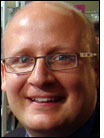Local soccer clubs in Nuremburg are testing an RFID-based system provided by the Fraunhofer Institute for Integrated Circuits (IIS), an applied research organization, that follows the movements of players and balls in order to provide automated score-keeping during games, as well as training beforehand. The system, known as RedFIR, enables team managers, trainers and referees to track the locations and movements of players and balls on the field, and thereby determine whether a goal is scored, as well as (in the case of training) how well players perform and whether they may require additional guidance.
The solution has been tested in Ireland with rugby players at Donnybrook Stadium, and is currently being trialed by local soccer clubs at Nuremberg’s easyCredit-Stadion (formerly known as Frankenstadion), where the FIFA World Cup Soccer games were held in 2006. Fraunhofer IIS is now seeking partners to market the solution in Europe, as well as globally. In the meantime, says René Dünkler, Fraunhofer’s technology marketing director, soccer clubs will continue testing the system with their own players.
In addition, Fraunhofer has developed a system employing a passive RF tag consisting solely of an antenna that has also been selected by the International Football Association Board (IFAB) as one of two finalists for a goal-line technology to detect when a team scores. With this technology, the RF tag is installed inside the ball, and antennas are mounted alongside the goal area. The antennas transmit a 120 kHz signal that creates a magnetic field. When the ball crosses through the magnetic field, its tag distorts that field. A receiver detects those changes and sends a message to the GoalRef software that a ball has crossed the goal line. During the next three months, IFAB plans to test the GoalRef system in order to assess its reliability, accuracy and robustness. The organization expects to make a decision in July 2012 regarding whether or not to approve GoalRef’s adoption.
With the RedFIR system, each player wears one or more battery-powered RFID tags, manufactured by Fraunhofer. The tags can be attached around one or both of the player’s ankles, over the shin guard, or attached to that individual’s shirt. Each device beacons a unique ID number at a rate of several hundred transmissions per second, using a proprietary air-interface protocol. At Frankenstadion, Fraunhofer installed 12 readers around the field that capture each tag’s 2.4 GHz signals. The readers then forward the IDs via a wired connection to a PC, where Fraunhofer software calculates each device’s location based on triangulation and the time difference of arrival (TDOA) of a tag’s signal. Another RFID tag is embedded inside a soccer ball, and transmits more frequently—approximately 1,000 times per second—in keeping with the higher rate at which the ball moves, compared with each player’s speed. The software can then provide data indicating where players are located at any given time during a game, and can enable coaches and referees to better understand what occurred during particular plays. For example, video footage can show much of what is happening in the vicinity of a ball in play, but the RedFIR system displays where every player was located on the entire field, as well as which players were within contact of each other, where the ball was located and the exact time at which it reached the goal.
The software displays a map of the field, with an icon displaying each player and the ball in real time. That map can be reviewed by team management and trainers, as well as by members of the media during a game. What’s more, the information can be made available to members of the public, via the Internet. Currently, the solution is still being tested by Nuremberg players, and the data is thus not being shared with the public at this time.
The software not only displays players’ movements in real time, but also tracks the number of goals and passes per player, and enables teams to trace back the actions leading to a particular goal. It offers offense and defense analytics, enabling a team’s coach to determine how well each player performed during a game, and can be used on practice fields to help team members with training.
In the event that a tag requires recharging, the player’s tag or the ball itself is placed in a wireless recharging station, where the battery is then recharged, after which it will last for about three to four hours.
In the future, Fraunhofer expects to provide tags with built-in sensors that could detect and then transmit the conditions of a ball or a player. For instance, it could send data about the air pressure within the ball, or regarding a player’s vital signs, such as heart rate. That additional information, however, would slow the tag’s transmission rate, Dünkler notes.


